SBAcoustics, SBA-7MD
Copyright 2022 © Troels Gravesen
Go to on this page:
DRIVERS
CROSSOVER
CABINET
WORKSHOP PICS
MEASUREMENTS
SPEAKER-KIT
CROSSOVER LAYOUT
Having had a lot of fun for the last two years with the
ScanSpeak
D8404/552000 mid-dome, the new SBAcoustics MD60N-6 obviously had my
attention too. Initial plans were for a 3-way with the MW19P-4 as the
mid-bass driver, but a friend suggested the MW19TX-4 as an alternative
and I had a pair of these. These have bowl shaped cones made from cross-woven carbon fiber material and tapping the cones with your finger
nail suggest a more than decent balance of stiffness and self-damping,
the inevitable compromise of physical properties.
Well, the midrange was given, being the key new component, and there was
no doubt in my mind I would use the TW29RN-B-8 for tweeter. I know it so
well and I like what it does - and it's a steal for the money.
For cabinet I wanted to do something different from the bass reflex
cabinets I've been doing the last few years: A transmission line. Problem with this is
that it makes placing the crossover inside the cabinet rather
troublesome, hence here placed within the base of the
cabinet. The bass crossover can be placed inside the cabinet just below
the bass driver on the internal panel. See images below.
I've done transmission lines before and they can add a dry and deep bass
- if done well. A transmission line is basically the opposite of a TQWT,
tapered quarter wave tube, and as a rule of thumb, the square area of
the line starts with something like 1.5-2 times the membrane area of the
driver - and ends with a square area around 0.5 times the membrane area.
Not at all that critical although some TL hardliners may tell you
different. The impedance profile of a TL will look similar to a vented
box with two peaks centered around the tuning frequency - here
determined my the length of the TL. If you stuff the TL fairly hard, you
can almost eliminate the impedance peaks, but at the expense of low-end
level.
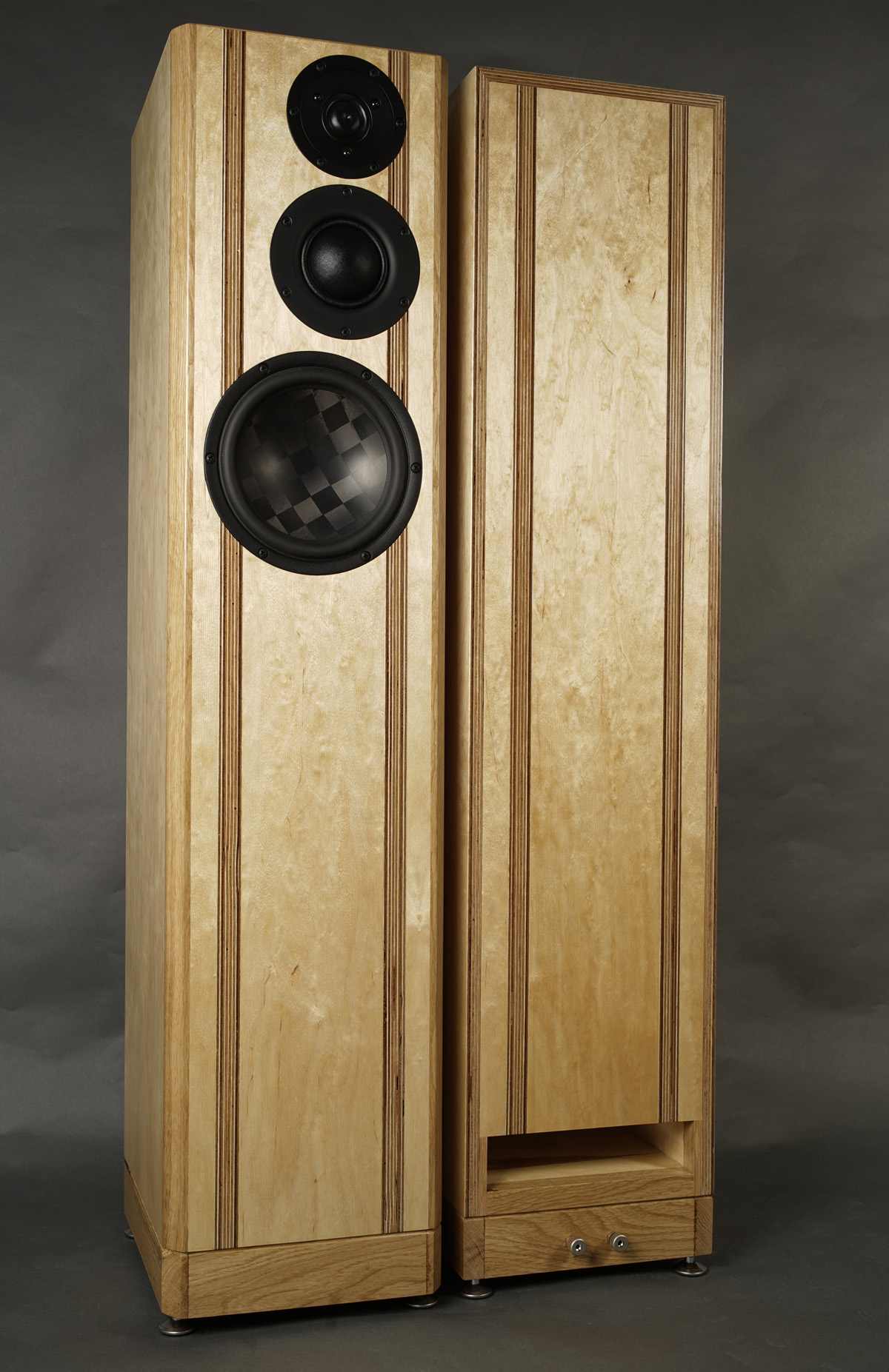
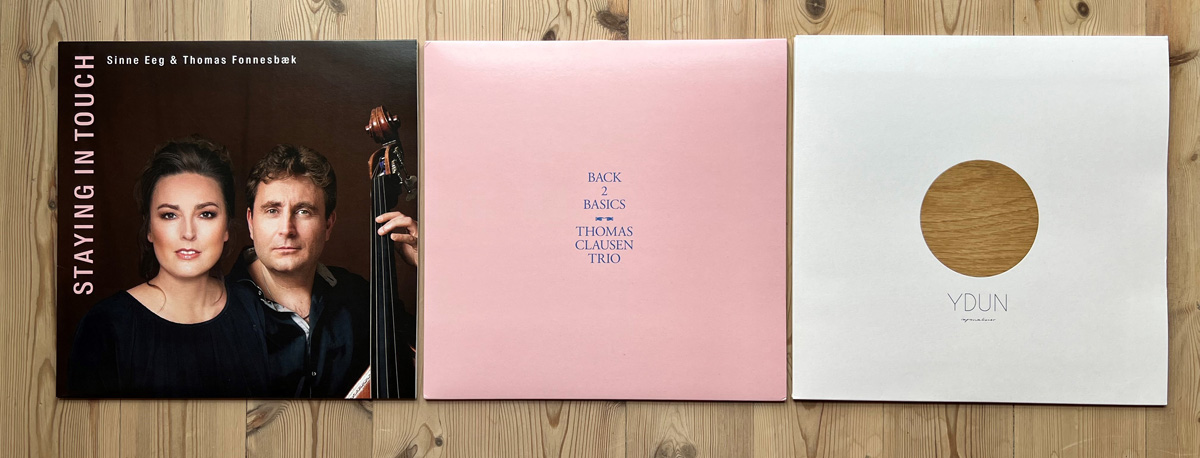
This may be a rather nationalistic selection
of records, but why not, when we have these talented musicians. The YDUN
record is a very special record featuring
Carsten Dahl on piano and Jonathan Slatto on cello, doing
improvisations. Use google translate for the link.
All of these are excellent recordings and with piano, bass, cello,
vocals and drums we have most ingredients for testing a loudspeaker's
ability to perform well.
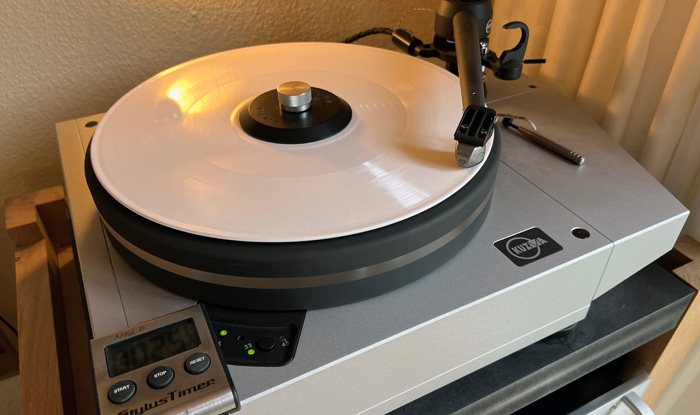
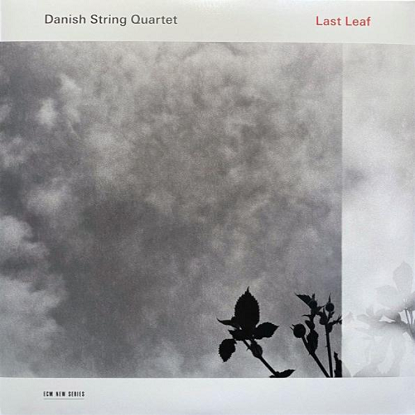
BTW: This YDUN record comes in white - and
with no label, rather engraved info. Basically I dislike pink, white or
whatever vinyl colour as you can't see dust as clearly as from black
vinyl, and I'm quite pedantic when it comes to cleaning records.
Suffice to say, all of these records - and many, many more - came out
beautifully on the SBA-7MD speaker. Large domes can do stuff in upper
mid and lower/middle treble that many smaller conventional cone speakers
mostly cannot, or they just do it differently. To my thinking it has to do with
beaming. We might think this would show up when we measure the
dispersion characteristics of a driver, but it just doesn't. We may
compare a mid-dome to a mid-cone and they show the same dispersion - yet
sounds quite different when we get into the middle treble range
(2560-5129 Hz). I have no evidence for this and should anyone have
ideas, let me know.
This is not to say cone drivers do it badly, not at all, just
differently, and it adds to the overall sonic signature - as do
mid-domes. All speakers are compromises.
Also the Danish String Quartet came out really well with no hardness to
the violins as is often the case at loud levels. This record is my litmus test for
midrange driver's ability of handling the middle treble and transition
to the tweeter dome. I also have to thank the Ortofon Anna D cartridge
for doing this...
Midrange clarity, treble smoothness and phenomenal deep bass considering
the size is what comes to mind from playing in my living room set-up. As
midrange driver goes, the ScanSpeak 12MU and SEAS W12CY006 have gotten
some serious competition from this MD60-N. Right, it doesn't go as low
as any of these 4" midrange drivers, but it does about an octave higher,
and the integration with tweeter is mostly easier and smoother. I also
guess the carbon midbass adds a significant portion of the midrange
clarity doing up to around 600 Hz, and again - I really wasn't expecting such a deep bass, partly thanks
to the transmission line, from such a relatively small driver. We tend
to think we're dealing with a potent 8" bass driver.
I certainly ought to do more transmission line cabinets - but not
always feasible from the target of compact designs - and not always as
easy as here where the midrange cabinet is small and inherent to the
driver. In a 3-way with separate cabinet for a 4-5" midrange driver, TLs
are not that easy to implement without the cabinet being significant
larger.
Basics:
3-driver speaker.
Dimensions: 24 x 28 x 105 cm, WxDxH.
System sensitivity: ~90 dB/2.8V/1 meter.
Impedance: 4-8 Ohms.
Power requirement: 20+ watts/channel.
Power handling: 100 watts.
Please
also read:
http://www.troelsgravesen.dk/power-handling.htm
Remember any burned driver is a misused driver.
Useful links (Please
follow all links before e-mailing!)
http://www.troelsgravesen.dk/tips.htm
http://www.troelsgravesen.dk/tips.htm#CONSTRUCTION_OF_CROSSOVERS
http://www.troelsgravesen.dk/crossovers.htm
http://www.troelsgravesen.dk/LCR-RC.htm
http://www.troelsgravesen.dk/Inverted-Polarity.htm
Also please read this:
http://www.troelsgravesen.dk/choices.htm
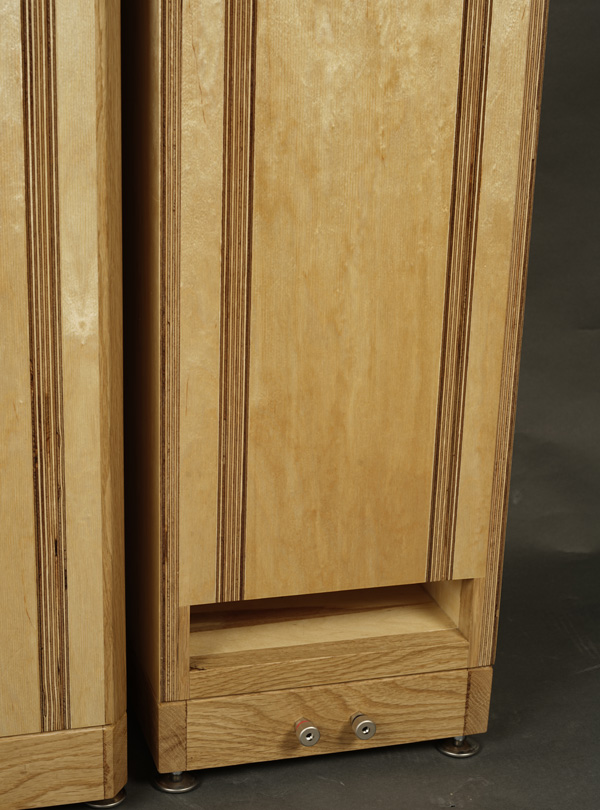
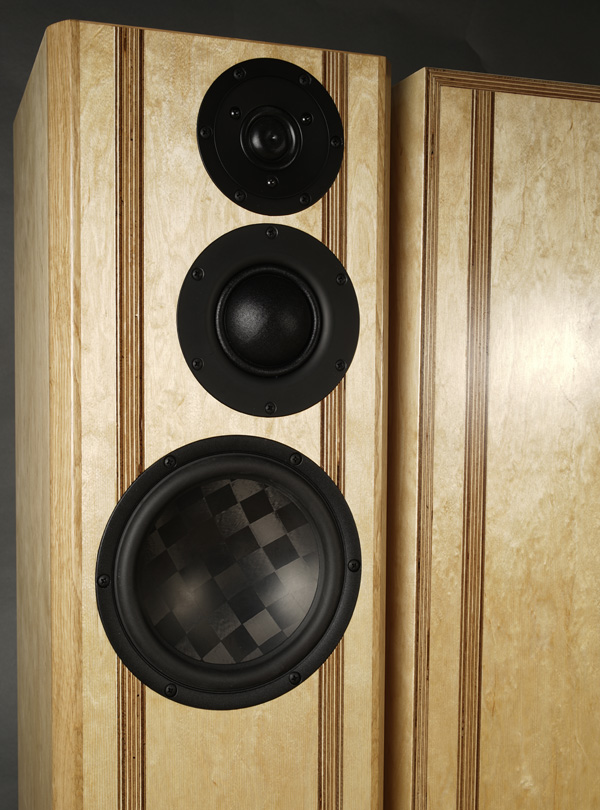
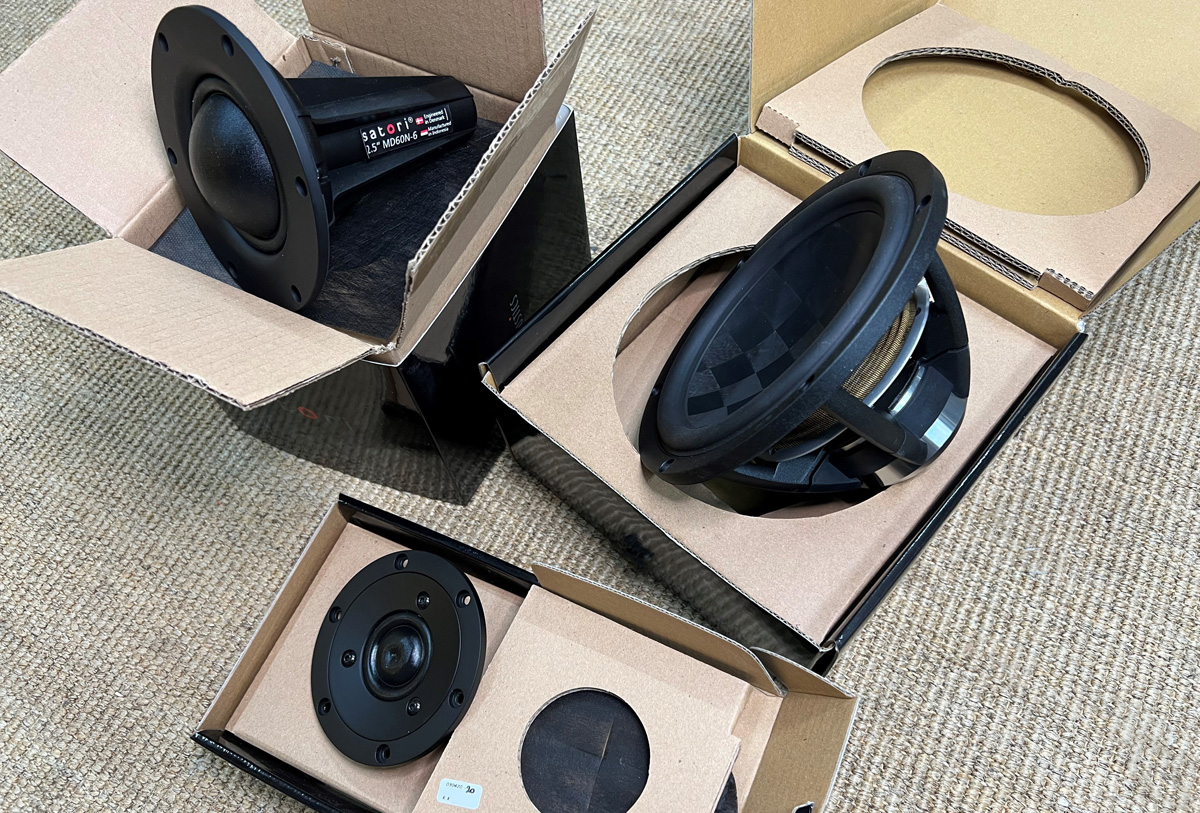
Download specs here: TW29RN-B-8
MD60N-6
MW19TX-4
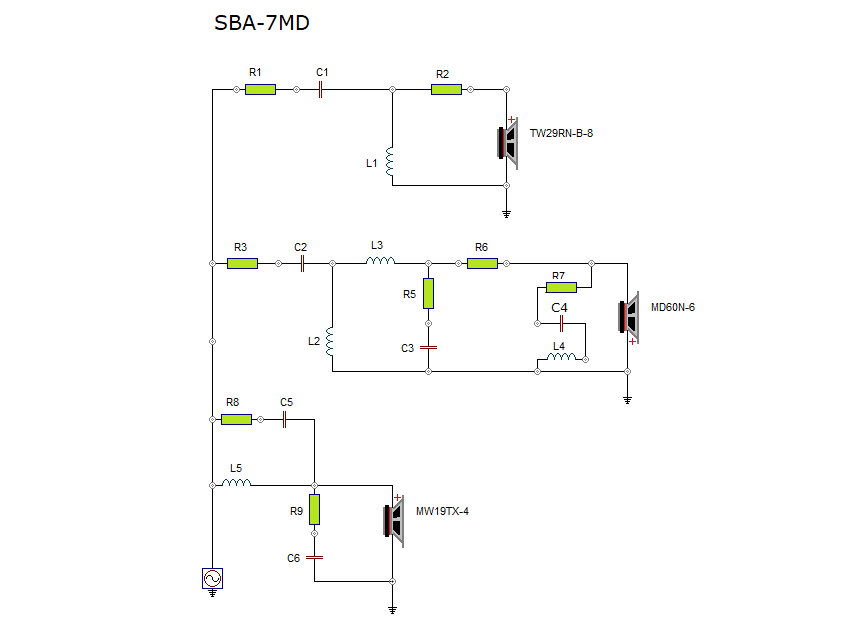
The filter is a straight forward LR2 filter. R7+C4+L4 takes care of the mid-dome's impedance peak and R8 and C5 reduce the mid-bass peak at 5 kHz. The latter not strictly necessary, but it costs little and does a bit of good.
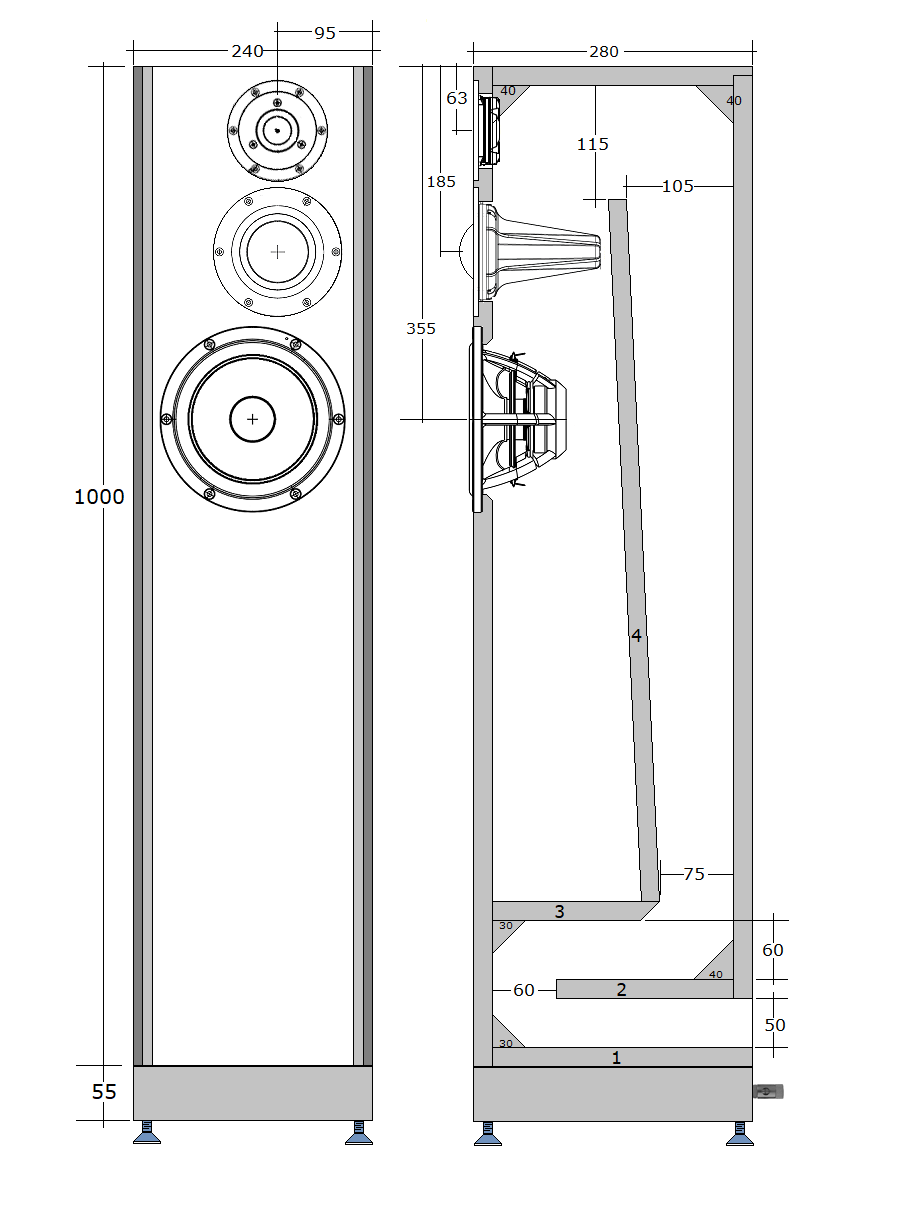
Cabinets were made from 21 mm Baltic birch. Use this or 19-22 mm MDF
without any change to outer dimensions. TLs are not that critical.
The front panel side fillets was chamfered 35 deg. This is optional, but looks nice I
think.
The base for the speaker was made from 30 mm solid oak and adjustable
feet like
this.
Use 20 mm for the rear section of the base structure to allow terminals
to protrude well. And please go through all parts of the
tips
page as you'll find a lot of tips on most frequent questions - saves me
e-mail time.

Base support.
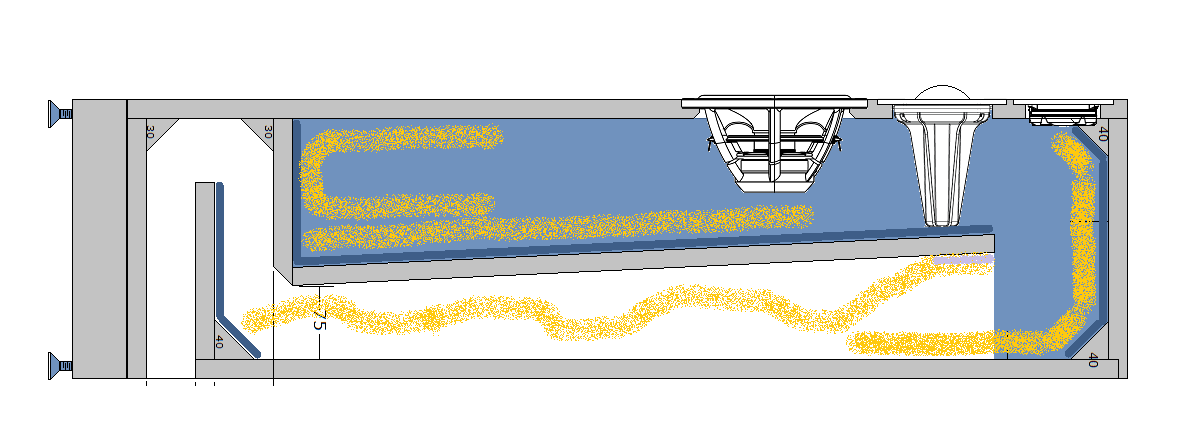
Cabinet damping: Add felt to internal panels (blue). Sides to top in
front section and on lower panel in TL.
Add two pieces of 22 x 50 cm Acoustilux at rear and bottom of front
section (yellow).
Glue at top a piece of 20 x 70 cm Acoustilux in rear section
of TL. See images below.
Extra acoustilux sheet, 25 x 30 cm, behind bass driver not show on
drawing above. See images below.
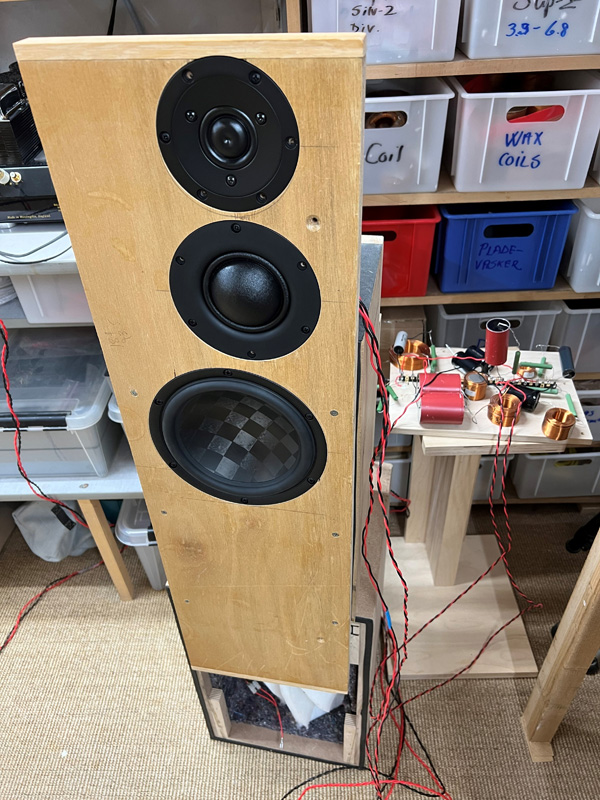
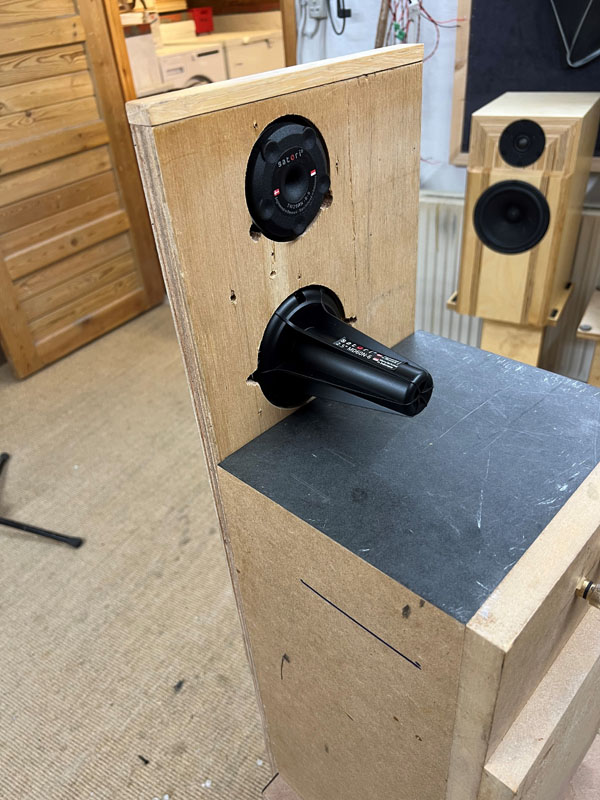
All speaker construction must start with a mockup to find out if this
combination of drivers and the intended cabinet has any reasonable
future. Measurements must be done, crossovers must be simulated and
tested in real-life before we start cutting panels. I was pretty sure
how the bass and tweeter would do on the intended panel - and
fortunately the mid-dome did well too. This was the joker in the game,
as it should have a frequency response manageable and not demanding a
too elaborate crossover. From past experiences I knew a mid-dome would
need impedance linearisation to allow a proper high-pass section, and
this dome was no exception. The impedance peak at ~400 Hz must be
flattened allowing a high-pass filter some ½ octave above.
Having a mid-dome also eliminate the need for a stepped baffle as the
acoustic difference between mid-dome and tweeter is too small to cause
trouble with phase integration.
I listened in mono and in stereo with the Illuminator-71 on the other
channel and I had to attenuate the SBA-7MD a little to match the
sensitivity of the Ill-71. The SBA-7MD is pretty sensitive and runs the
best from my EAR-861 at the 8 Ohms tabs - something almost all speakers
do, despite low impedance in some areas.
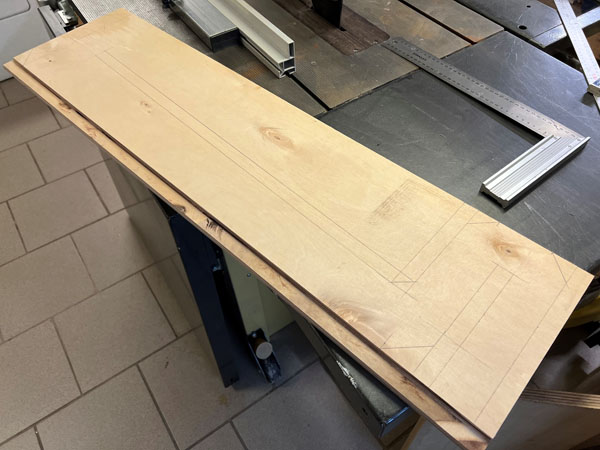

Mark up the internal panels as seen to the left.
And NO!, the panels are not made from a laminate, what you see is the
rebate for the rear panel.
I started gluing panel 3 to 4, not gluing 3+4 to the side panel yet.


Start gluing the bottom panel (1) and make sure it is 100%
perpendicular!
Add the reflector.
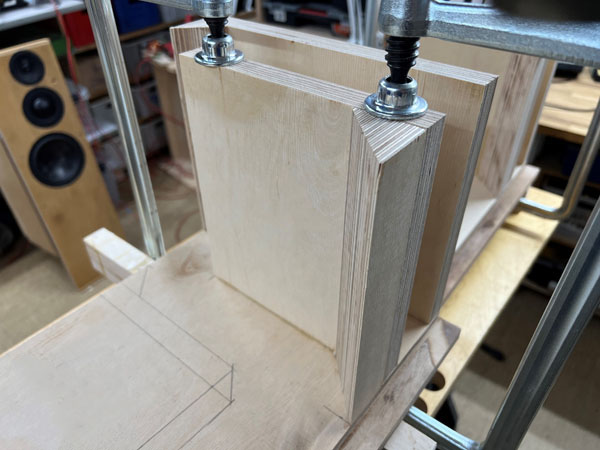
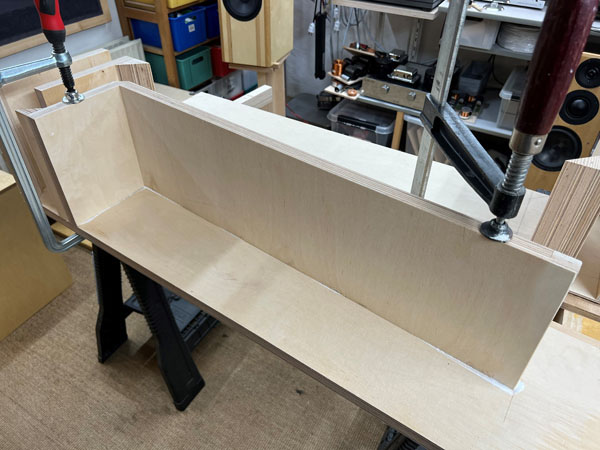
Left: Glue panel #2 in place. Right: Glue panel 3+4 in place.
Add reflectors all along.
Make reflectors from some softwood like spruce. Not BB as seen here as i
gets extremely hot when cutting 40 mm BB at an angle of 45 deg. My fire
alarm beeped like crazy!
It was kind of nice again making a transmission line! TLs or TQWTs can do stuff with the bass and despite it taking up quite some space compared to a reflex enclosure, a floor-stander like this will take no more floor space than a stand-mount.
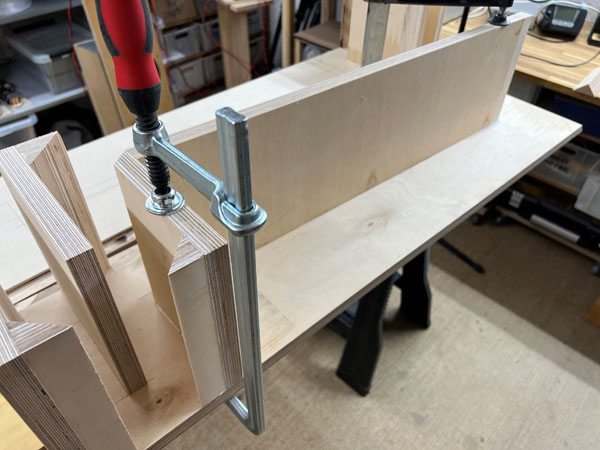
Left: Add reflector to panel 3+4.


Left: Prepare rear panel. Right: From front, ready for felt and
acoustilux damping.
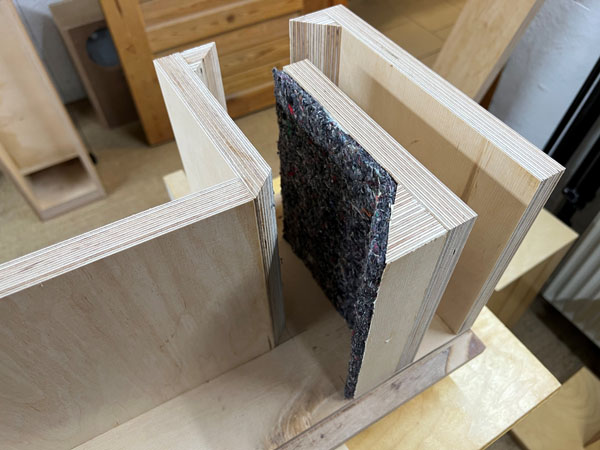
 Add felt to panel
2. Add acoustilux to rear chamber and fix at top with staples or glue.
Add felt to panel
2. Add acoustilux to rear chamber and fix at top with staples or glue.
Basically this piece of acoustilux is just hanging from the top of panel
4.
Assemble the cabinets except front panel. This we will do last.

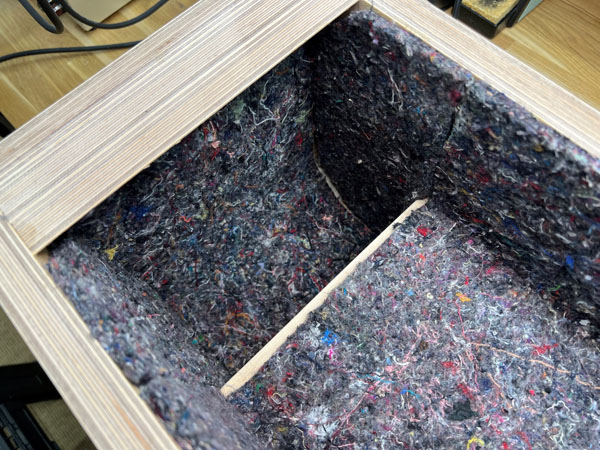
Add felt to all internal panels in front and top section.
Fasten with
vinyl glue or similar.
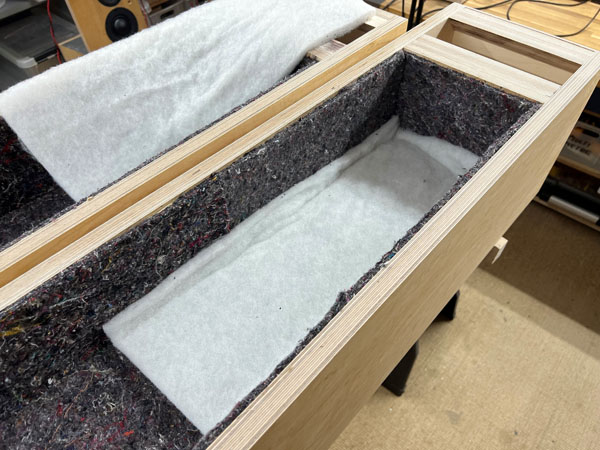
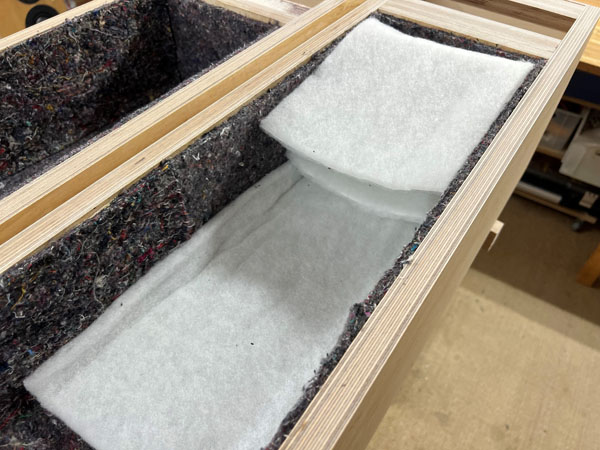
Add acoustilux as seen on photos and drawing above.
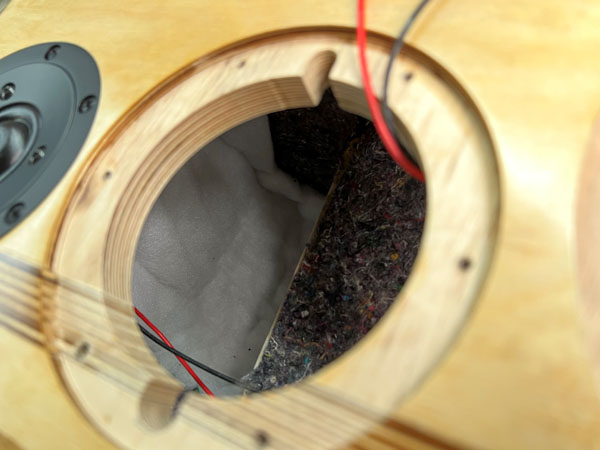
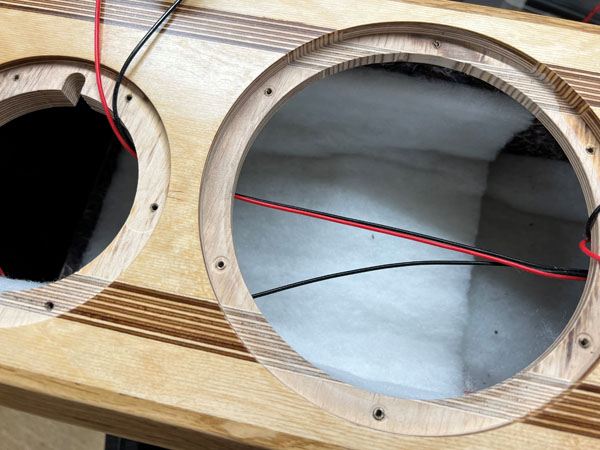
Add 1 piece of 22 x 50 cm to the top panel (left image).
Add one piece of 25 x 30 cm behind the bass driver.
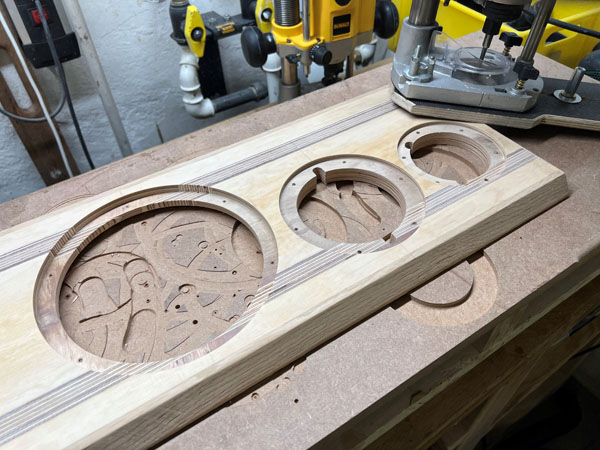
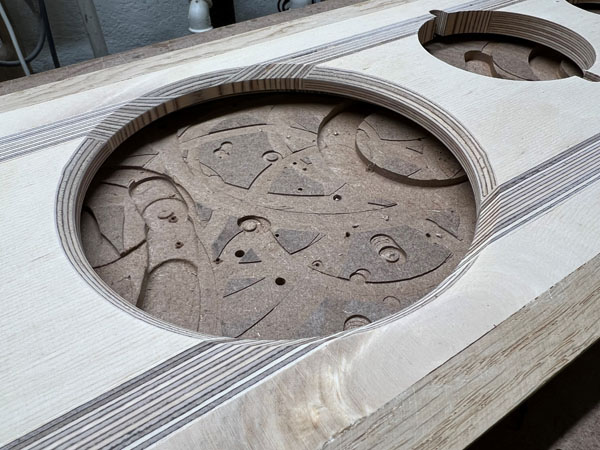
Routing for drivers. Chamfer the bass driver hole slightly, 8 mm/45 deg.
is enough.
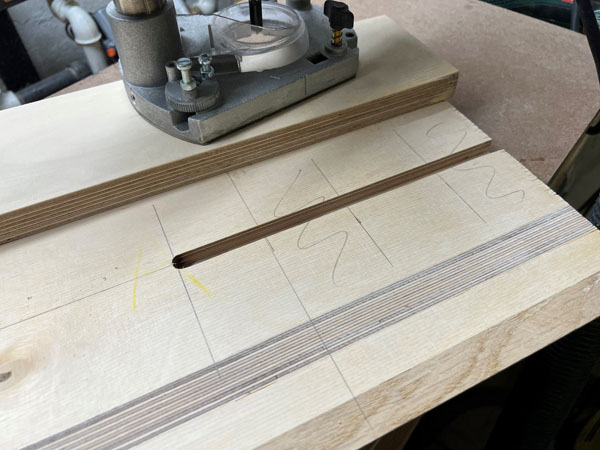
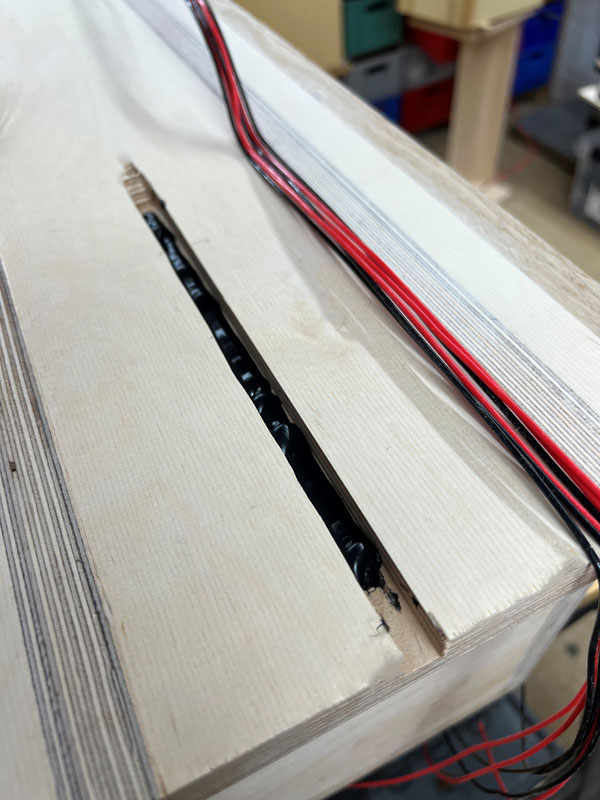
How to get wires from the bottom to the drivers:
You may drill holes in panel 1-2-3 - or make a groove in the front panel
like seen here.
I made a 10 x 10 mm groove, added Superfix at bottom, added the wires and
covered with Superfix.
This ensures no leakage between sections of the TL.
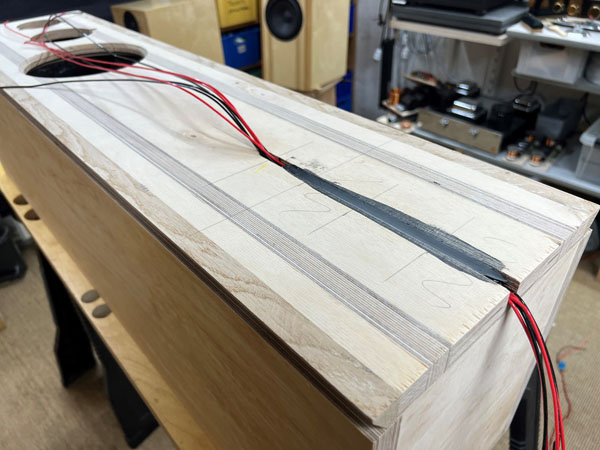
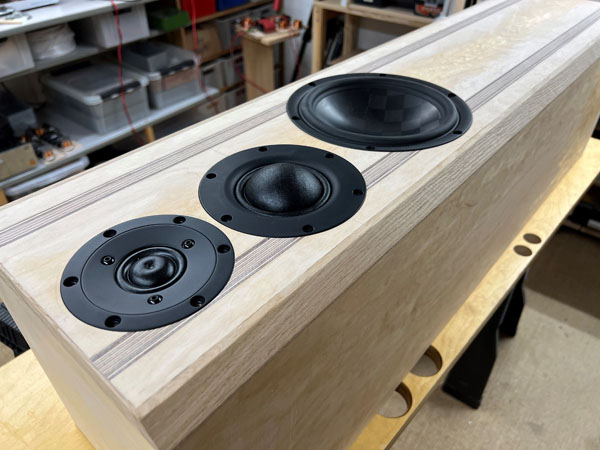
Left: Ready for mounting the front panel. Right: Testing driver rebates.
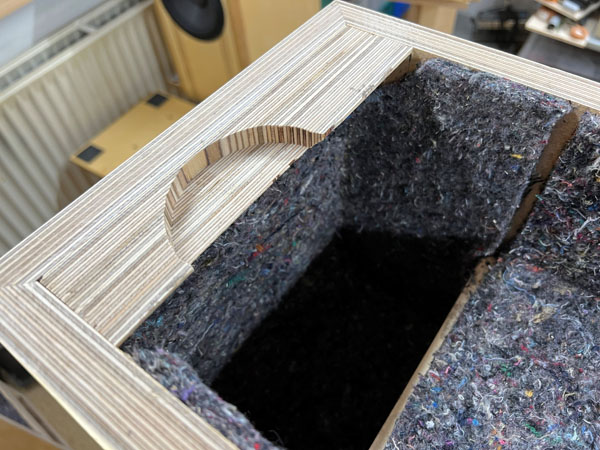
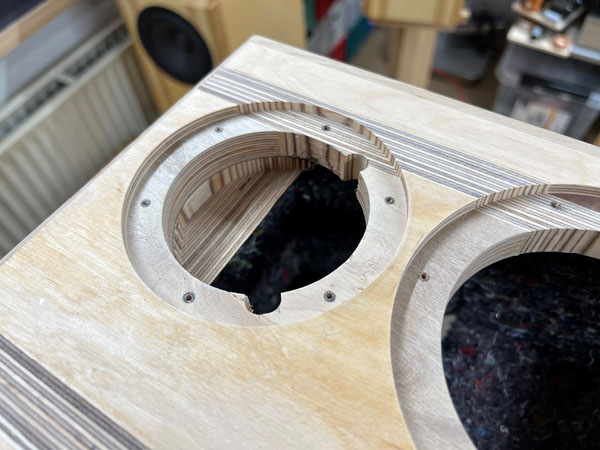
The tweeter needs some more depth, hence rout some extra 10 mm in the
reflector. I did this free-hand.
Do this before you add felt damping! (dust).
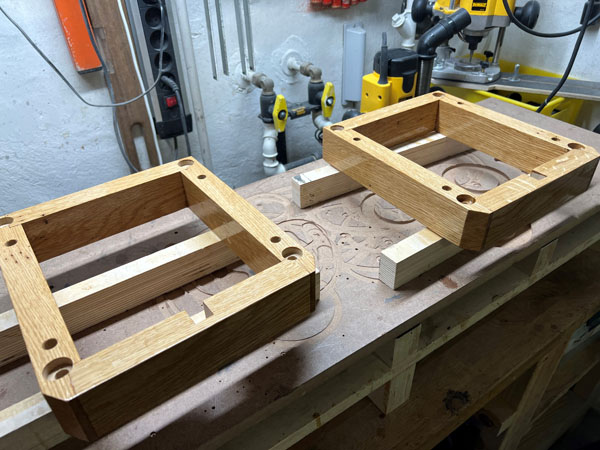
Making the base frame from solid oak glued with epoxy. Here with the
first coat of lacquer.
Obviously you can make the cabinet in one by increasing height to 1055
mm and lift the bottom panel, panel 1.
For feet I use
this.
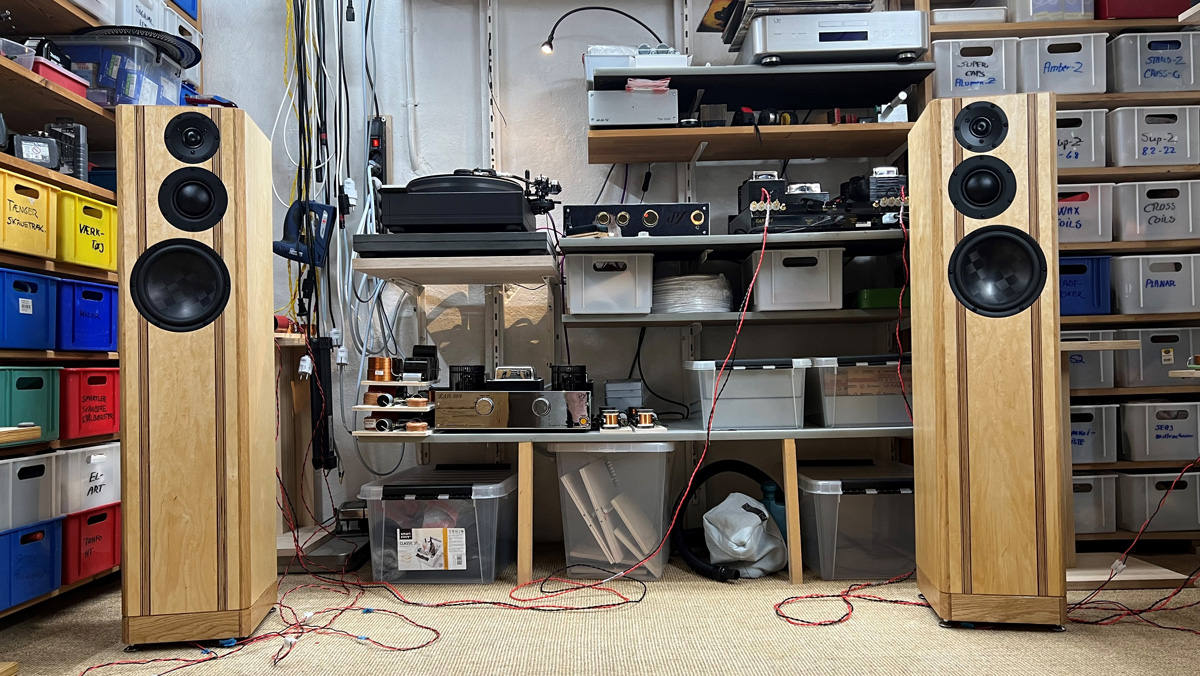
First time full workshop setup with prototype crossovers.
I like what I hear. Does my string quartet very well - and violins can
be tough.
And really impressive rendering of the bass in Tin Pan Alley by Stevie
Ray Vaughan.
This TL does its thing and goes surprisingly deep.
A few comments on
MEASUREMENTS before you start interpreting the readings below.
First of all, if we think measurements will
tell us how a speaker sounds, we're wrong. The perception of sound is
way too subjective to be reflected in any measurements we can perform. A
loudspeaker system is meant to give us a satisfying idea of an acoustic
event and for some people a pair of 5 USD ear-plugs are enough, others
spend 200 kUSD on a truly full-range pair of speakers - and the latter
may not be happier than the former.
Measurements may give us an idea of tonal balance of a system, i.e. too
much or too little energy in certain areas, although dispersion
characteristics play a vital role here. A two-way 7+1 and a three-way
7+4+1 may display similar horizontal dispersion, yet sound very
different. Measurements may tell us about bass extension if far-field
measurements are merged with near-field measurements. In addition to
this, ports may contribute to bass extension. Most of we diy'ers do not
have access to an anechoic room for full-range measurements from
20-20000 Hz.
What cannot be seen is what kind of bass performance we get in a given
room. Bass performance is highly dependent on in-room placement of your
speaker and the same speaker can be boomy in one place and lean in
another. Actual SPL level at 1 meter distance and 2.8V input is useful
for en estimate of system sensitivity and combined with the impedance
profile may give an idea of how powerful an amplifier is needed to drive
the speaker to adequate levels.
What measurements do not tell is the very sound of the speaker unless
displaying serious linear distortion. The level of transparency, the
ability to resolve micro-details, the "speed" of the bass, etc., cannot
be derived from these data. Distortion measurements rarely tell much
unless seriously bad, and most modern drivers display low distortion
within their specified operating range.
Many people put way too much into these graphs and my comments here are
only meant as warning against over-interpretation. There are more to
good sound than what can be extracted from a few graphs. Every graph
needs interpretation in terms of what it means sonically and how it
impacts our choice of mating drivers, cabinet and crossover design.
What measurements certainly do not tell is the sonic signature of the
speaker, because speaker cones made from polypropylene, aluminum,
Kevlar, paper, glass fiber, carbon fiber, magnesium, ceramics or even
diamonds all have their way of adding spices to the stew. Nor do
measurements tell what impact the quality of the crossover components
add to the sound, from state of the art components to the cheapest of
coils and caps, they all measure the same if values are correct, yet
sound very different.
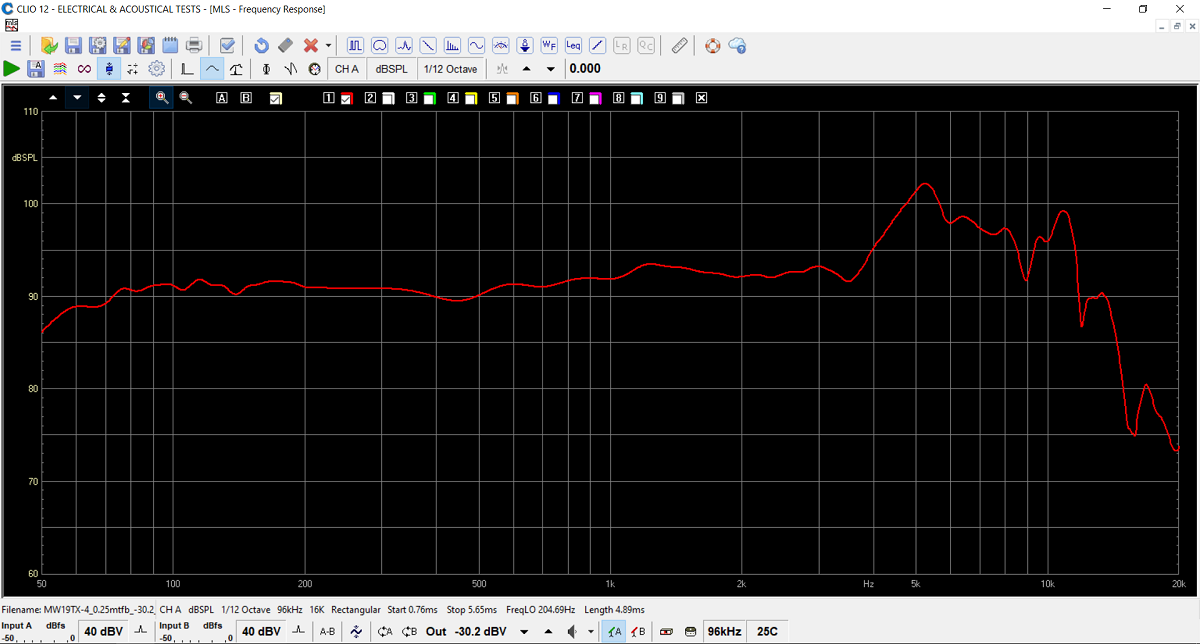
Frequency response of MW19TX-4 on an
"infinite baffle", 80 x 120 cm, merged with nearfield response @ 200 Hz
in a closed box of 34 litre.
Not bad at all and definitely no rubber edge resonances around 1 kHz.
Nice.
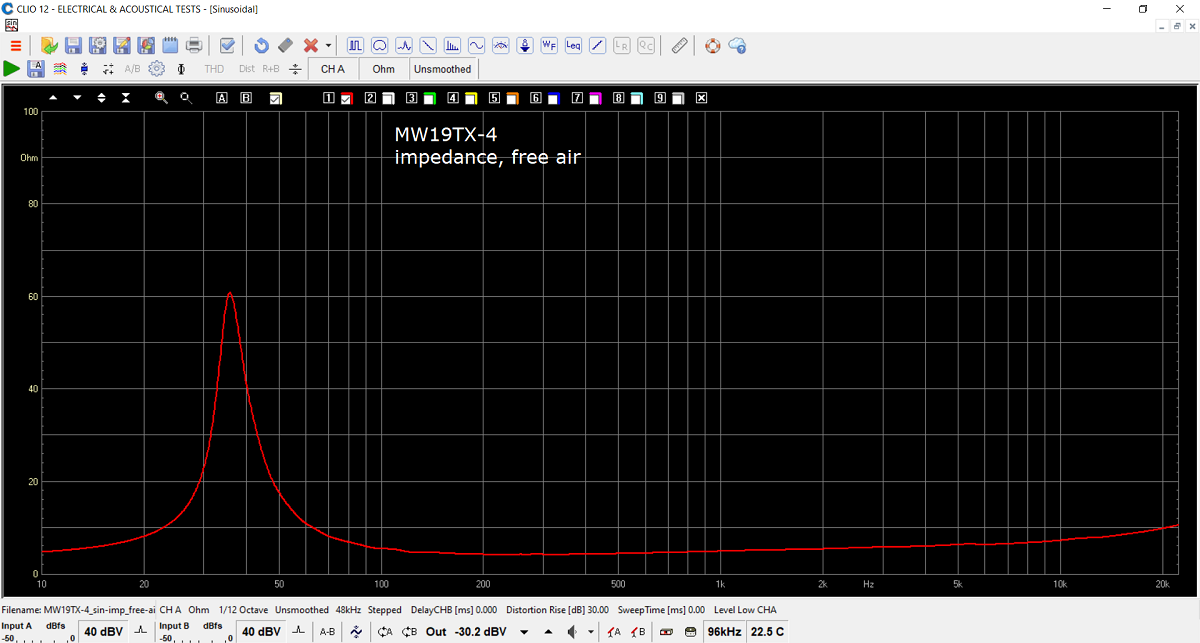
MW19TX-4 free air impedance. Not a trace of disturbance around 1 kHz,
not even if we blow up the scaling to 10 Ohms. Minor irregularity at
5400 Hz, but who cares.
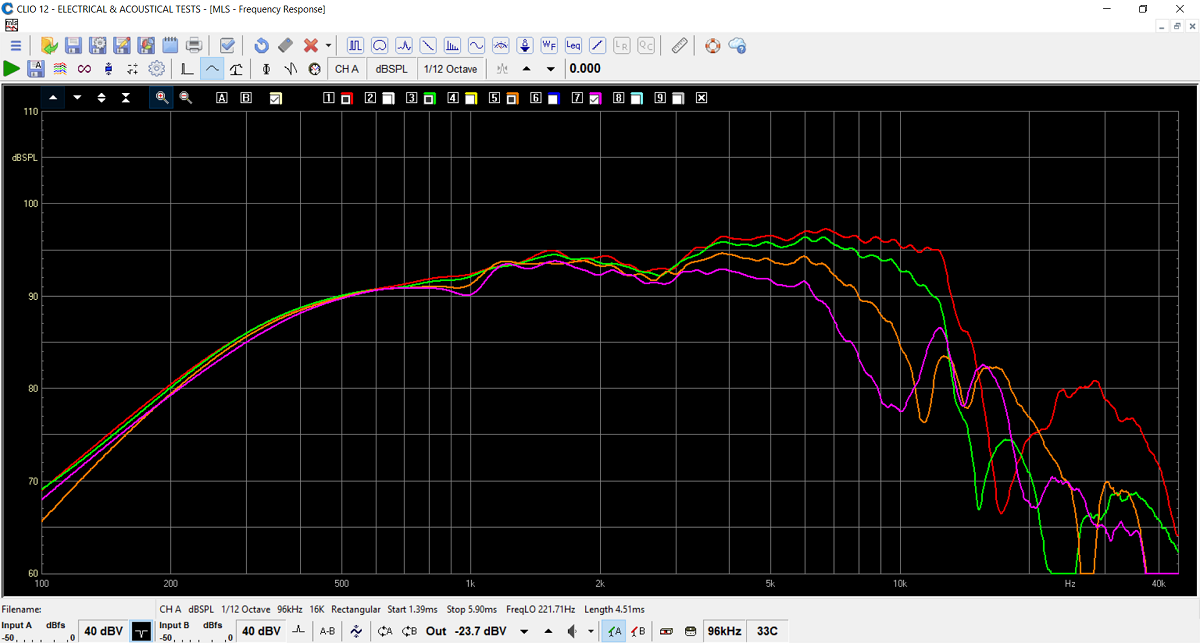
The MD60N-6 on the same baffle, 80 x 120 cm,
at 0, 10, 20 and 30 deg. off-axis.
Fairly smooth and no peaks at all in all of its intended frequency
range.
From simulation it proved an easy driver. And this driver goes high and
can play treble.
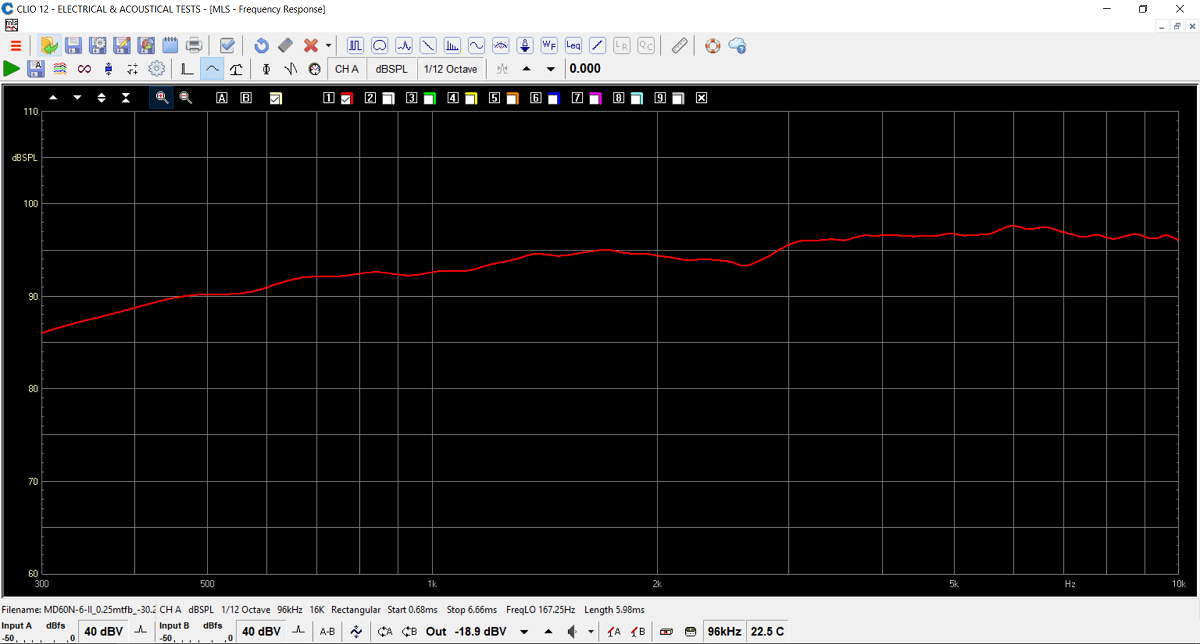
In a more relevant range of 300-10000 Hz, the mid-dome looks really
nice.
This on a 80 x 120 cm baffle.
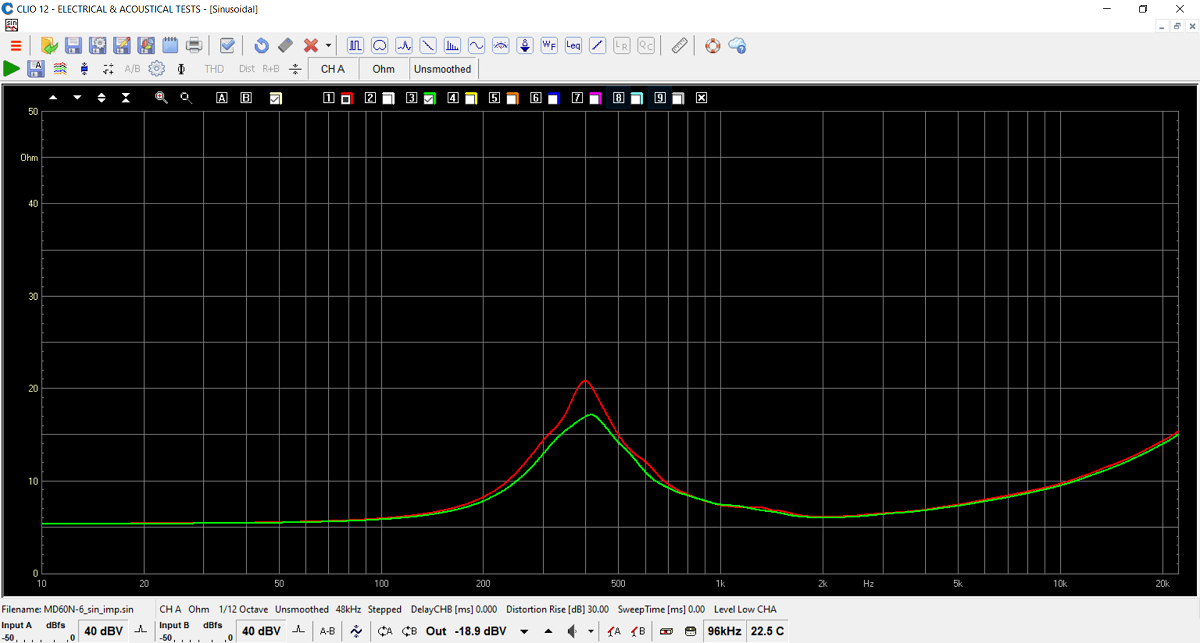
Impedance of the two MD60N-6 units.
Apparently SBA chose to give it an impedance of 6 Ohm to avoid making
both 4 and 8 Ohm drivers. Makes sense.
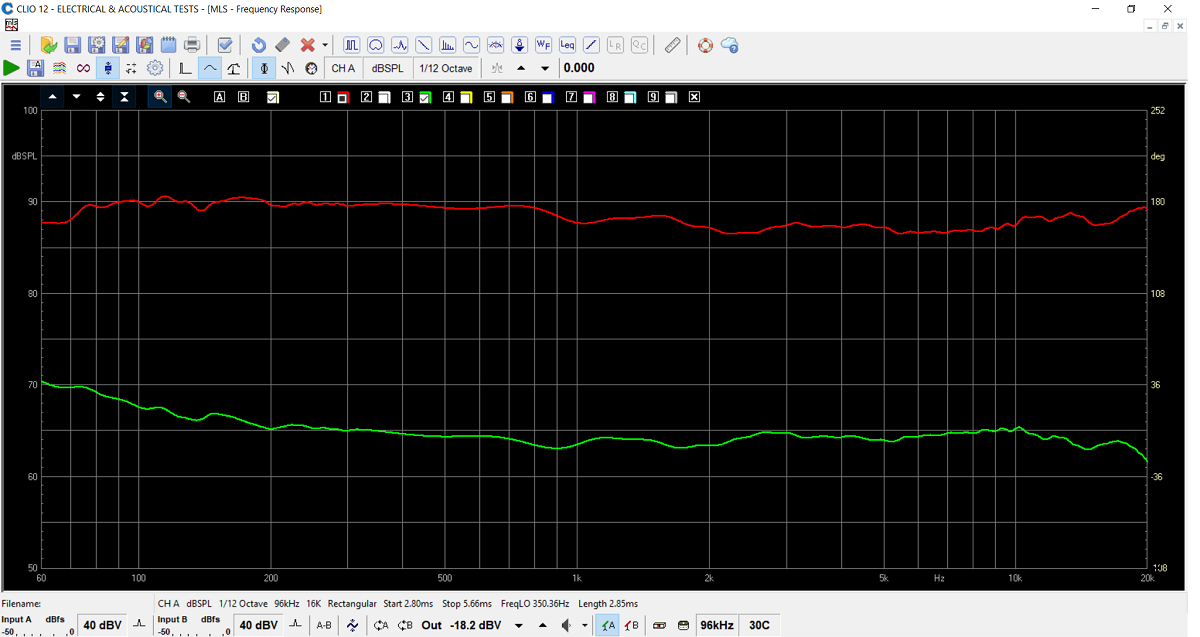
Frequency response (red) and minimum phase
(green) of final speaker.
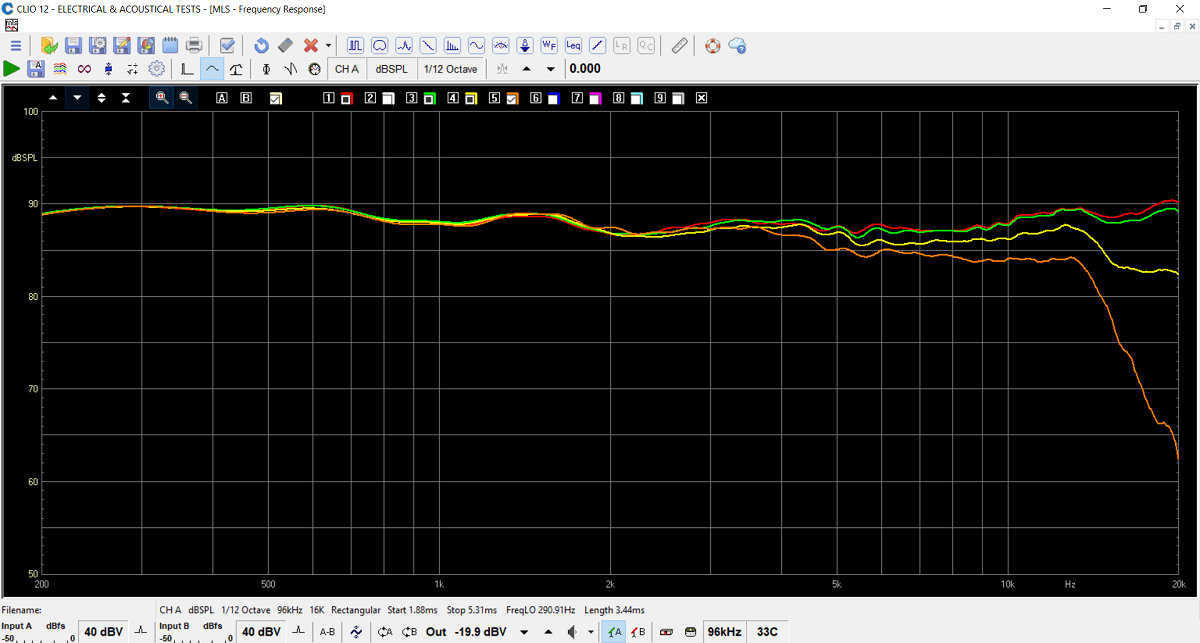
Horizontal dispersion at 0, 10, 20 and 30
deg. off-axis.
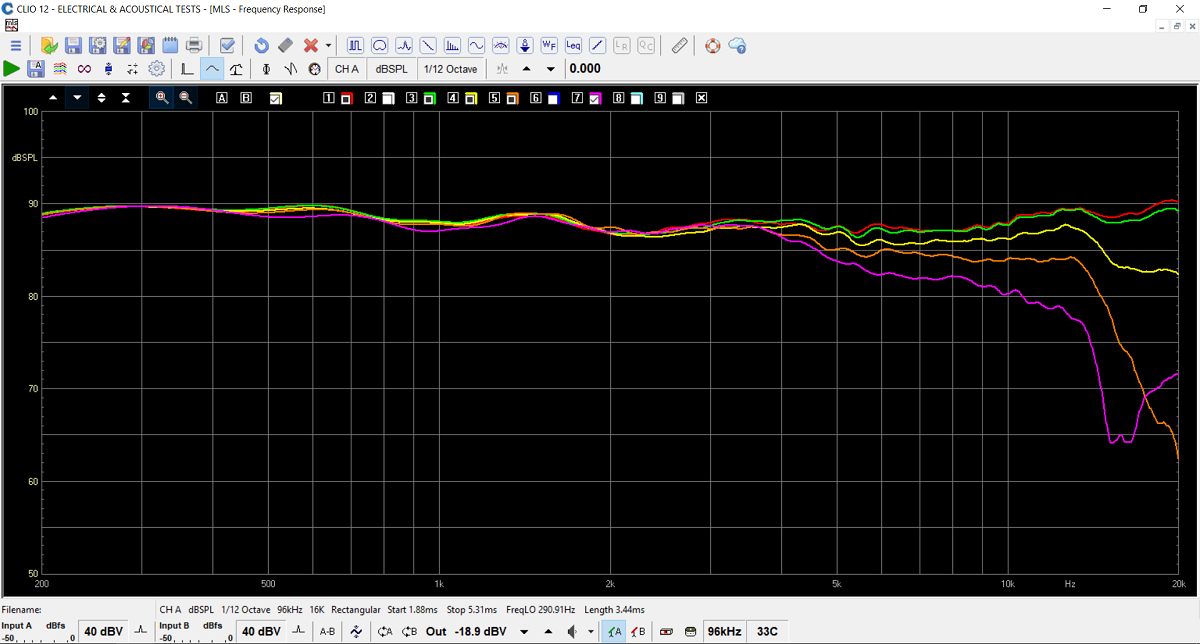
Here 40 deg. off-axis included.
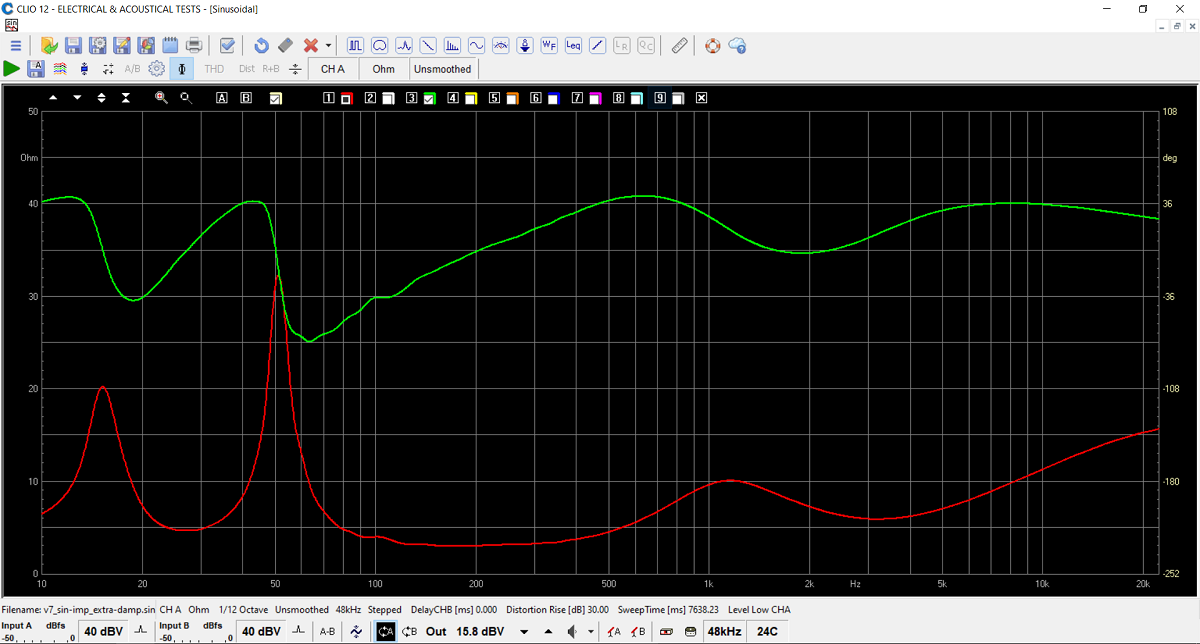
Final system impedance.
"Port" tuning around 28 Hz, which is quite low for the TL.
Minimum impedance is 3 Ohms - and my tube amp EAR-861 doesn't mind from
its 8 Ohms tabs, from which it sounds the best.
Again: Which tube amp tab suits a loudspeaker the best must be tried every time.
Just because a speaker is specified 4 Ohms or 8 Ohms, doesn't tell which
winding of the output transformer does it best.
And for those thinking their "NN watts/channel @ 8 Ohms" amplifier is
not comfortable with this speaker, don't worry. Any decent solid state
amp is happy with anything from around 2 Ohms and up. I have this
question too quite often.
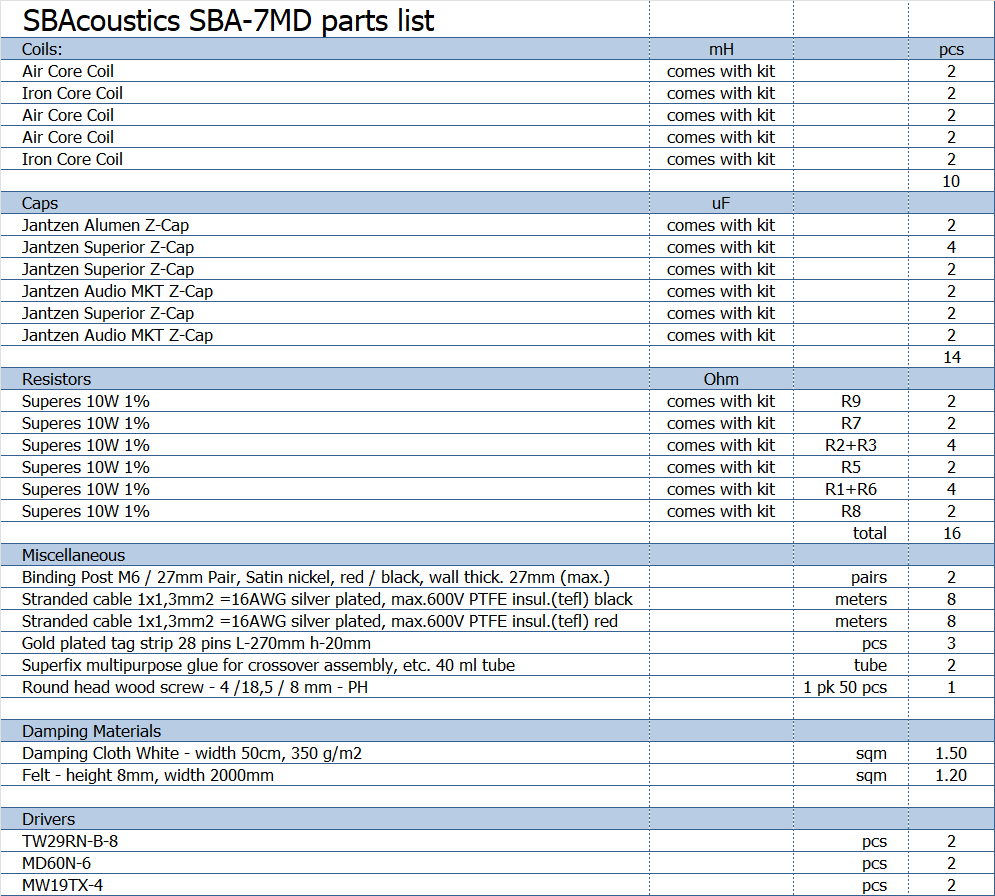
All kit and component prices may be subject to change and are always to be confirmed by Jantzen Audio Denmark.
Kits can always be bought with/without drivers, or some of the drivers.
Download Complete Kit Sale Presentations:

All technical questions to troels.gravesen@hotmail.com
All questions regarding purchase of kits, please mail Jantzen Audio at contact@jantzen-audio.com
CROSSOVER-LAYOUT
BACK TO INDEX
Check this out before start making crossovers:
http://www.troelsgravesen.dk/tips.htm#CONSTRUCTION_OF_CROSSOVERS
- and please remember this:
http://www.troelsgravesen.dk/LCR-RC.htm
- which I am sure you have read already :-)
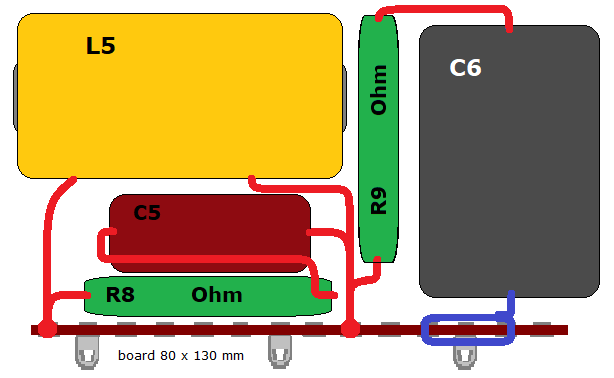
Crossover layout for bass.
Use ½ solder tag strip/crossover.
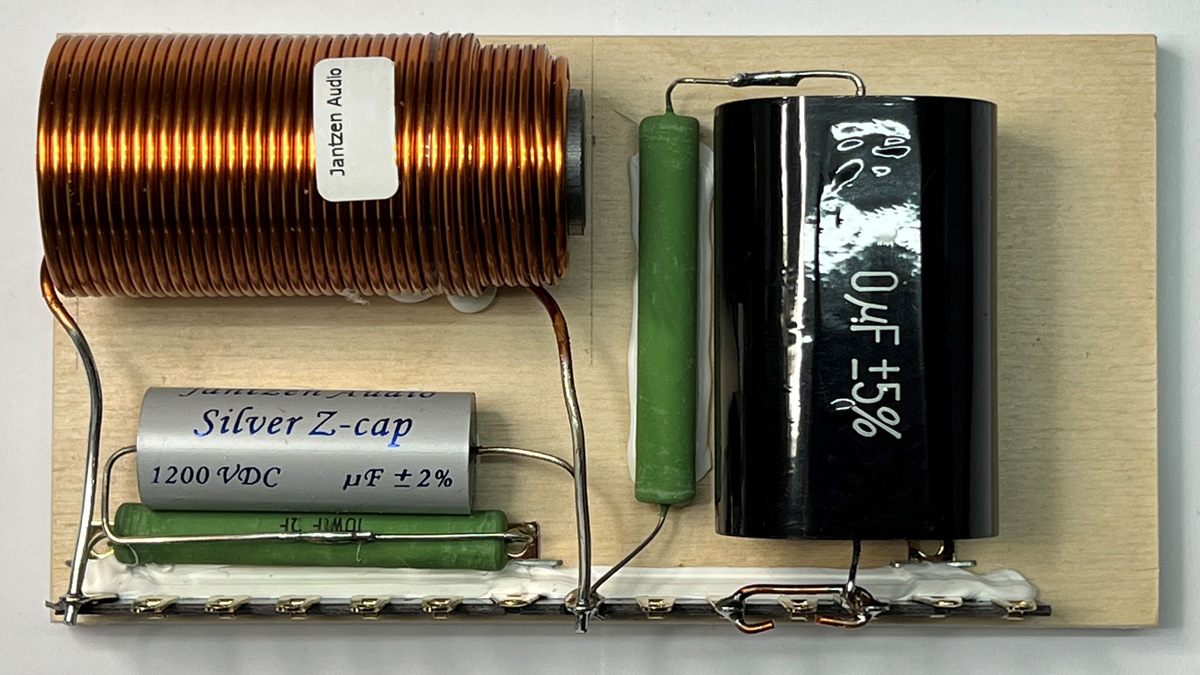
C5 comes as Superior-Z, not Silver-Z as seen here. No difference in
sound.
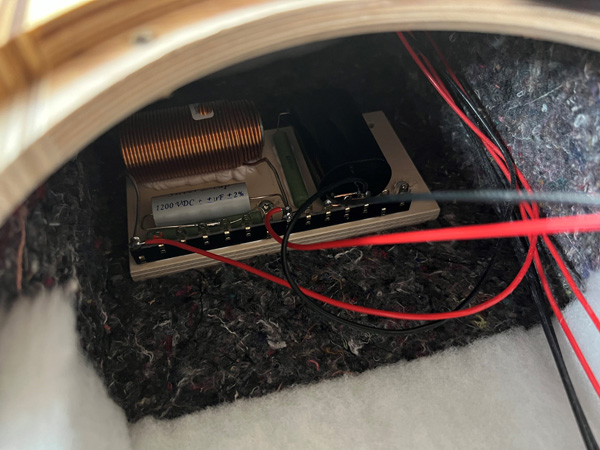
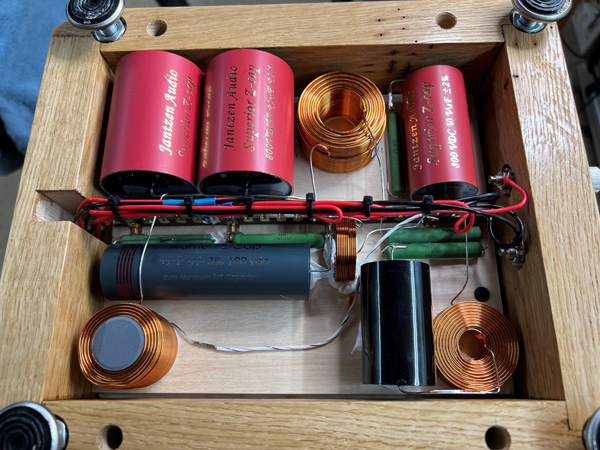
Left: Place bass crossover below the bass driver on panel 4. I use 40 mm
screws at an angle of 45 deg. This to get the coil as far away as
possible from the driver's magnet.
Right: MT section at the bottom.
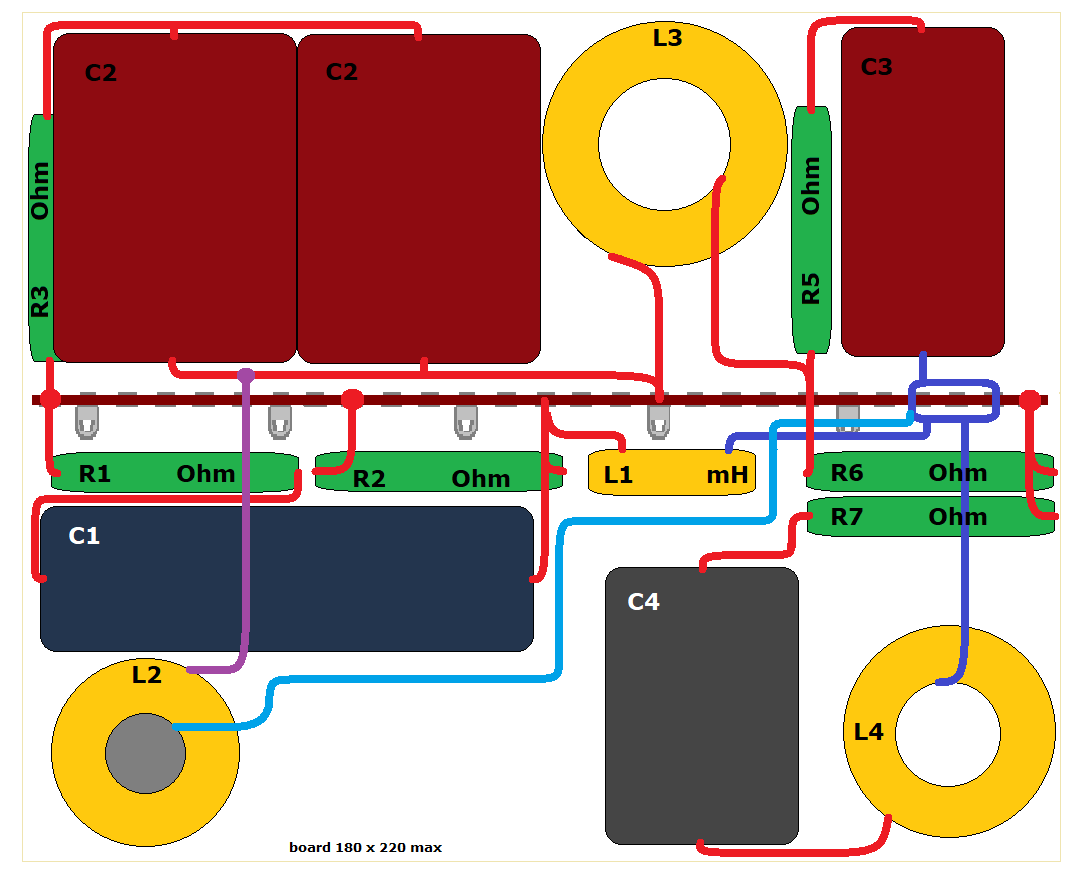
Layout for mid-dome and tweeter.
In order to get all the coils as far away from each other as possible,
some wires have to be made from L2, one to the output of C2 and the
other to the ground loop.
Make sure it fits within the bottom frame. I cut my board 178 x 218 mm,
but it obviously depends on your choice of materials for the base frame.
Mine were 30 mm. In hindsight I would have made the rear panel of the
base frame from 20 mm material, rather than 30 mm.
I moved the upper part of the crossover 1 cm to the left to make room
for the binding post.
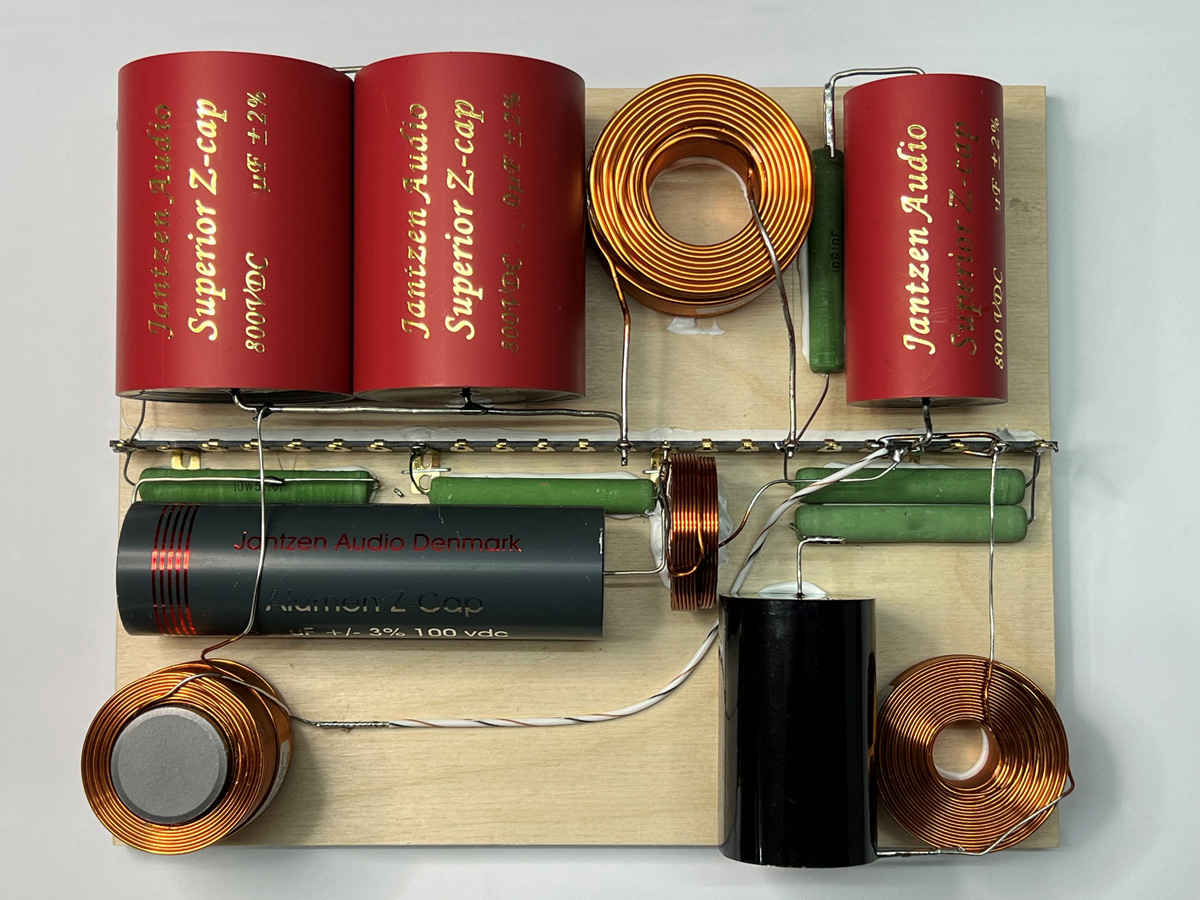
Notice the wire from L2 to ground.
Also I turned L1 90 deg. due to space.

SPEAKER WIRING:
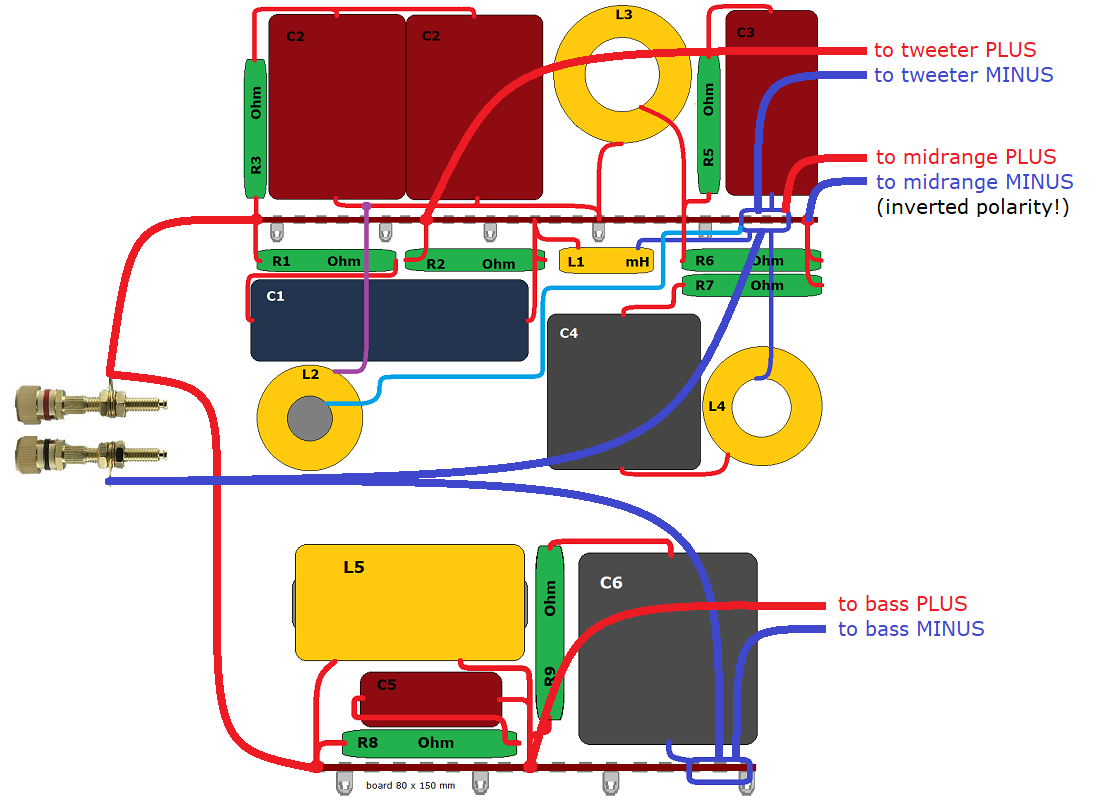

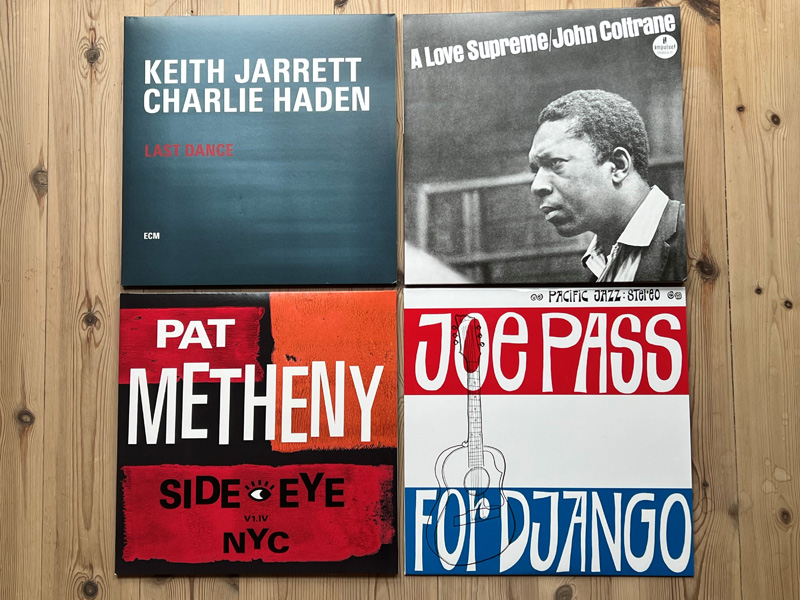
While testing the SBA-7MD I picked up these records from my local vinyl
pusher. Keith/Charlie - a must have record and Keith's piano comes
through beautifully and so does not least the upright bass of Charlie.
I recently watched a documentary on John Coltrane on Swedish TV and it
tricked my curiosity although anything previously heard of Coltrane
(alone) hasn't caught ear. Just too much bee-bob. What he does with
Miles Davis is another story. In fact, one person interviewed,
who had been at a concert with Coltrane, told half the audience would
leave during the concert. He was way ahead of his time and I'm not sure
what it takes to fully appreciate his playing, I just don't have it.
It's like the Pat Metheny tribute to Ornette Coleman... my brain is just
not wired for this. A Love Supreme is supposed to be the
pinnacle of Coltrane, Coltrane's Kind of Blue, but this is not
a great mix, and I guess the mono version may be better as
Coltrane's sax i so much in the left channel is sounds really weird. I
switched my EAR-912 to mono; better, but now rather compressed... I have
promised myself I'll hear this record several times to better understand
why some people just can't live without it. It's like roquefort cheese.
I hated it and then decided to eat it continuously for half a year - and now I
can't live without it.
All the same, Metheny's Side Eye NYC record is so much for my
brain. I love it, maybe because it so much reminds me of the late 70'ies
when I bought Bright Size Life (still have it) and my musical
life took a radical turn. Great live recoding here from New York. Highly
recommended.
I have some Joe Pass records - and having played the guitar myself - I
always liked his playing. Smooth and relaxing. Great recording too.
None of these records left me wishing the SBA-7MD speakers do
differently. Smooth midrange/treble and deep bass when needed.